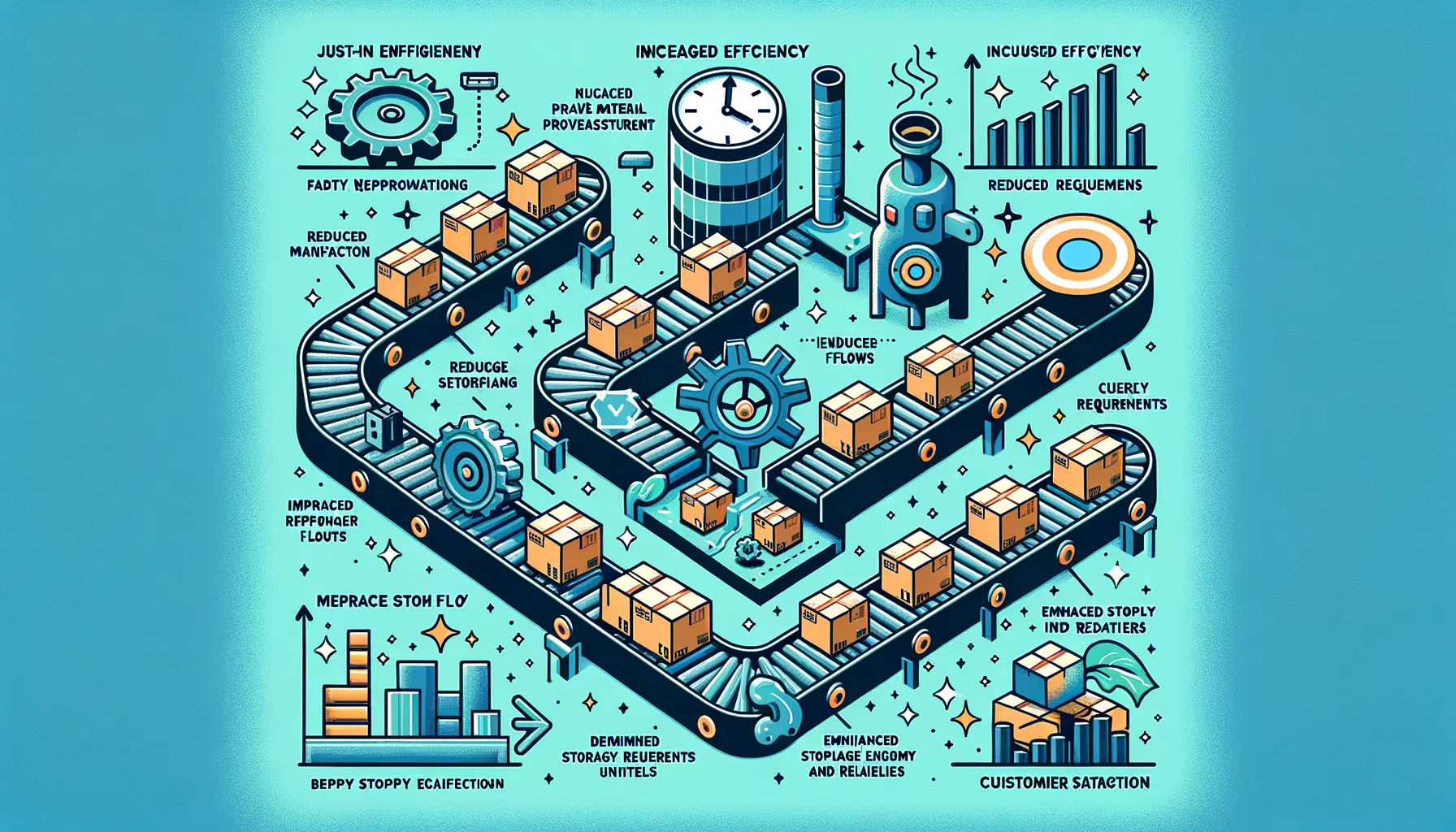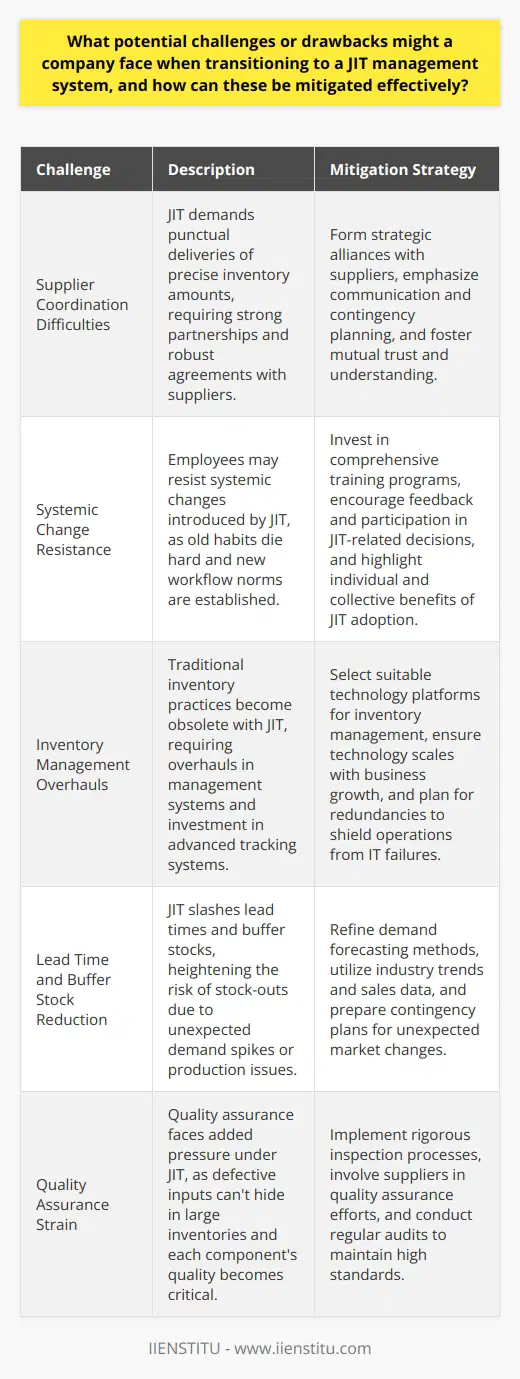
The concept of Just-in-Time (JIT) has revolutionized the way industries approach inventory management and production processes. JIT is a methodology that aims to increase efficiency, reduce waste, and decrease the costs associated with holding inventory by ensuring that materials are received just as they are needed in the production process.
The history of JIT traces back to the Japanese manufacturing industry where it emerged as a response to the need for a more efficient production system capable of challenging Western industrial giants. This article provides an in-depth examination of JIT's strategic impact on modern business practices.
By scrutinizing the JIT philosophy and its applications, we will explore both the myriad benefits as well as the challenges that organizations face when implementing this strategy.
The origins of JIT are steeped in the Toyota Production System, and it is within this framework that we'll dissect the elements that have made it a cornerstone of operational management. Further, this article elucidates on how JIT is integrated into problem solving training courses and offers insight into the advantages that an online certificate course in JIT can offer to professionals.
At the end of this journey, readers will gain a comprehensive understanding of JIT and how it continues to influence the strategic decisions made by businesses across various industries. Let's embark on this intellectual exploration into the JIT strategy's enduring legacy and its continued relevance in today's fast-paced economic landscape.
Understanding JIT Methodology
The Principles of JIT
Just-in-Time manufacturing is anchored in a set of core principles that together create a robust framework for enhancing production efficiency. The most fundamental principle is the elimination of waste, which JIT interprets broadly, encompassing not just material waste but also time and resources spent on overproduction, waiting, and unnecessary motion.
Another key component is the right sizing of production, ensuring that items are produced in the quantities needed and when they are needed. Synchronization is also vital in JIT, coordinating the production flow so that each step occurs seamlessly without interruptions or excess inventory.
Together, these principles foster an environment where continuous improvement is not just encouraged but is a requisite for maintaining competitiveness.
Understanding the JIT Production Strategy
The JIT production strategy can be visualized as a finely tuned orchestra where each section plays precisely in time, the goal being to respond quickly to customer demand without the associated costs of overproduction and stored inventory.
One hallmark of the JIT system is the "pull" method where downstream activities signal the need for upstream production, contrasted with the traditional "push" method where production is forecast-driven.
Such tight integration requires a responsive supply chain and a focus on quality - for JIT to work, every component produced must be near perfect to prevent bottlenecks. This strategy requires an intimate understanding of the production process, a reliable forecasting of demand, and a deep cooperation with suppliers to ensure timely delivery of materials.
Advantages of Implementing JIT
Reduction in Inventory Costs
One of the most significant benefits to employing JIT methodology is the substantial reduction in inventory-related costs. By receiving goods only as they are required in the production process, companies can minimize the amount of capital tied up in unsold stock.
This approach drastically reduces storage space necessary, thereby diminishing rent or storage facility costs. Fewer goods in storage also mean lower risk of inventory being damaged or becoming obsolete.
The financial liquidity provided by reduced inventory costs can then be used more strategically within other areas of the company to fuel growth and innovation.
Increase in Efficiency and Productivity
JIT inherently promotes an increase in both efficiency and productivity by streamlining the production process. As the system demands a high level of quality and the seamless movement of goods, it encourages the optimization of work processes, resulting in a more organized and efficient use of labor and machinery.
Employees become more skilled in multi-functional roles, and equipment downtime is reduced through better maintenance practices. Consequently, the organization can achieve higher output with the same resources, translating into better margins and competitive pricing.
Improved Customer Satisfaction
In a market where customer satisfaction is paramount, JIT offers significant advantages. By aligning production schedules closer to customer demand, businesses can offer faster delivery times and more reliable service.
Inventory reduction also enables more flexible responses to changes in customer preferences, allowing companies to adapt more quickly to market trends. An increased focus on quality, as necessitated by JIT, means that customers receive products that meet high standards every time, enhancing the company's reputation and customer loyalty.
Challenges of Implementing JIT
Risk of Supply Chain Disruptions
While JIT offers numerous benefits, it is not without challenges. The system's dependence on a smooth, uninterrupted flow of goods makes it particularly vulnerable to supply chain disruptions. Issues such as supplier unreliability, transportation problems, or unforeseen events like natural disasters can halt production and cause delays in delivery.
Since JIT maintains minimal inventory levels, even small hiccups can have significant downstream effects. It's therefore critical for businesses to assess the reliability of their supply network and develop contingency plans to mitigate such risks.
Strains on Workforce
JIT can also impose strains on the workforce. The expectation for quality and efficiency may translate to increased pressure on employees to perform without error. The lack of inventory buffer means that production delays directly impact the entire production schedule, which can lead to stress and overwork.
The multi-skilled nature of JIT requires significant training and adaptability from employees, who must be proficient across various roles. Businesses must be cognizant of these demands and provide the necessary support, training, and engagement strategies to maintain a positive work environment.
The Role of JIT in Modern Business
JIT in Service Industries
While JIT originated in manufacturing, it's found a place in service industries as well. Service businesses like restaurants, hospitals, and retailers apply JIT principles to manage inventory, improve customer service, and streamline operations.
By reducing unnecessary on-hand materials, service providers can reduce costs and waste, while improving order turnaround times. In a JIT-focused restaurant, for example, ingredients are ordered and delivered based on forecasted demand, ensuring freshness and reducing spoilage without affecting the customer experience.
JIT in Manufacturing Industries
In manufacturing, JIT has continued to evolve and is widely implemented across various sectors. Through just-in-time manufacturing, companies aim to minimize the time lapse between the order and the delivery, thereby accelerating the turnover rate and reducing the capital tied up in the production process.
By closely monitoring demand signals and maintaining a lean supply chain, manufacturers can drastically cut lead times and respond nimbly to shifts in consumer preferences or market conditions. Manufacturers are incorporating technologies such as IoT and AI to enhance the JIT system, further improving efficiency and responsiveness.
The Future of JIT in an Increasingly Global Economy
As the economy becomes more global and interconnected, the role of JIT is expanding. Companies are now looking at JIT not just within the confines of their organization but across their global supply chains.
This expansion adds complexity due to factors like increased lead times, varying regulatory environments, and the need for agile responses to global market fluctuations. However, with advancements in technology and communication, JIT can provide companies with a strategic advantage, enabling rapid scaling and flexibility in diverse market conditions.
A thorough investigation of the JIT methodology reveals a nuanced picture of its strategic impact on business operations. The advantages of implementing JIT—ranging from decreased inventory costs and heightened efficiency to enhanced customer satisfaction—are testament to its enduring relevance. In parallel, an awareness of the challenges, including the risk of supply chain disruptions and the pressure on the workforce, offers a balanced perspective on JIT implementation.
The flexibility that JIT provides is essential in an environment where businesses must adapt to changing consumer demands and market dynamics swiftly. As we encourage further exploration of JIT, it is important to remember that continued education, such as enrolment in problem solving training courses or an online certificate course in JIT, can provide valuable insights and skill enhancements benefiting individuals and organizations alike.
Frequently Asked Questions
What are the key operational and financial implications of implementing a JIT strategy in a manufacturing enterprise?
Understanding JIT Strategies
A JIT, or Just-In-Time, strategy streamlines production. It aligns orders with production schedules. This method reduces inventory size. It requires precise and responsive supply chain coordination. The implications of JIT are diverse. They affect both operations and finances. These changes can have profound effects on a manufacturing enterprise.
Operational Implications
1. Reduced Inventory Levels
JIT minimizes inventory. Raw materials arrive as needed. This reduces inventory costs. Storage and handling costs also drop. Enterprises can repurpose saved space.
2. Improved Quality Control
JIT emphasizes quality production. Defects become more noticeable. Manufacturers address quality issues faster. Continuous improvement becomes the norm.
3. Enhanced Supplier Relationships
Successful JIT necessitates close supplier ties. Manufacturers rely on timely deliveries. Supplier partnership becomes critical. These relationships often require more management.
4. Increased Dependence on Demand Forecasts
Forecast accuracy matters more. High demand variability complicates JIT implementation. Manufacturers must respond quickly to changes. Accurate demand predictions become essential.
5. Elevated Risks with Supply Disruptions
Supply chain disruptions become more impactful. Any delay can halt production. Enterprises must manage risk smartly. They often need a backup plan.
6. Workforce Flexibility
JIT demands flexible workforces. Employees must adapt to shifting responsibilities. Cross-training often becomes necessary. This flexibility can improve overall efficiency.
Financial Implications
1. Cost Reduction
JIT can lower costs significantly. Less inventory reduces capital tied up. Storage and wastage costs also fall. This can improve an enterprise's financial health.
2. Cash Flow Improvement
Lower inventory levels free up cash. Enterprises can invest this cash elsewhere. Cash flow becomes a strength. Financial flexibility often improves.
3. Investment Shift
Investment priorities can change. More funds may go towards technology. Reliable and quick manufacturing becomes paramount. Automation and IT systems often receive more investment.
4. Vulnerability to Market Fluctuations
Tight inventory control links closely to demand. Sudden market changes can lead to issues. If demand drops, production scales down. Costs savings can turn into under-utilization.
5. Potential for Cost Increases
Ironically, costs sometimes rise. Frequent small deliveries may cost more. Supplier premiums for reliability become common. These costs must find balance with savings.
6. Focus on Value-added Activities
JIT encourages focus on activities that add value. Non-value added activities are reduced or eliminated. Focus shifts to processes that directly contribute value. This can enhance competitiveness and profitability.
In conclusion, JIT strategies are complex. They carry both benefits and challenges. Manufacturers must weigh operational changes against financial impacts. Precise execution and coordination are key. JIT can lead to significant advantages when implemented carefully. It can boost efficiency, reduce waste, and improve financial performance. Enterprises must stay agile and responsive to maximize JIT benefits.

How has the adoption of JIT methodologies influenced global supply chain management practices?
JIT Methodologies and Global Supply Chain Management
Origins and Principles of JIT
Just-in-Time (JIT) methodologies emerged from Japan. They primarily focus on enhancing efficiency. Lean production is at their core. JIT aims to minimize waste. This waste can be in time, inventory, or production inefficiencies. Companies that adopt JIT tailor production to demand. This approach reduces inventory at different stages. The idea is simple. Produce only what you need. And produce it just before it's needed.
Impact on Inventory Management
JIT has revolutionized inventory management. Traditional methods involved keeping large stocks. In contrast, JIT encourages lower inventory levels. Businesses carry only necessary stock. They avoid excess. As a result, inventory costs drop significantly. Companies enjoy improved cash flow. However, JIT requires precise demand forecasting. It also depends on reliable and flexible suppliers.
Supplier Relationships
Successful JIT implementation hinges on strong supplier partnerships. Businesses need timely and consistent quality delivery. Relationships with suppliers become collaborative. Both parties aim for mutual benefit. Dependency on suppliers increases, though. Disruptions in supply can halt production.
Responsiveness and Agility
Adapting JIT has demanded responsiveness. Supply chains must respond swiftly to changes. Agility becomes essential. Businesses must adjust production quickly. They need to meet changing customer demands. This agility offers a competitive edge. But it also exposes businesses to risks. Any disruption can create significant issues.
Supply Chain Integration and Technology
JIT requires integrated supply chains. Information must flow seamlessly. Technology plays a key role here. Advanced information systems are critical. They enable real-time data sharing. Businesses and suppliers must sync their systems. This integration supports JIT's precision and timing needs.
Risk Management and Resilience
JIT methodologies expose supply chains to certain risks. Disruptions can come from various sources. Natural disasters, political instability, or supplier failures pose threats. Companies must develop risk management strategies. They need contingency plans. This task involves balancing JIT principles with resilience. It's a delicate equilibrium to maintain. Some stockpiling may be necessary. Diversification of suppliers can mitigate risks.
Environmental Impact
JIT impacts the environment as well. Reducing waste promotes sustainability. Lower inventories mean less overproduction. This reduction benefits the planet. It also aligns with corporate social responsibility goals. Businesses operate greener and more sustainably.
JIT's Influence
JIT has significantly shaped supply chain management. It has ushered in an era of efficiency. The focus has shifted toward waste reduction and precision. Relationships with suppliers are deeper and more strategic. The adoption of JIT requires integrated technology. Supply chains are now faster and leaner.
However, they also face increased vulnerabilities. Balancing efficiency with resilience is the key challenge. JIT's adoption continues to influence global supply chain practices. Its principles are now integral to modern strategies. Businesses that embrace JIT navigate a fine line. But those who master it can thrive in a competitive market.

What potential challenges or drawbacks might a company face when transitioning to a JIT management system, and how can these be mitigated effectively?
Challenges of Transitioning to JIT
Supplier Coordination Difficulties
Companies often struggle with just-in-time (JIT) transitions. Supplier coordination stands out as the first hurdle. JIT demands punctual deliveries of precise inventory amounts. Any supplier delay can stall production. Thus, firms must nurture reliable supply chains. This calls for strong partnerships and robust agreements. Timely communication proves essential in this dynamic. Supplier risk assessments can pre-empt disruptions. Diversifying suppliers may also bolster supply chain resilience.
Systemic Change Resistance
Employees may resist systemic changes. Old habits die hard, and JIT introduces new workflow norms. Education and training ensure staff embrace JIT philosophies. Highlighting JIT benefits can secure employee buy-in. Cultivating a change-ready culture facilitates smoother transitions.
Inventory Management Overhauls
Traditional inventory practices become obsolete with JIT. Overhauls in management systems are necessary. Real-time inventory tracking becomes a prerequisite. Thus, companies need investment in advanced tracking systems. These systems must align with JIT's stringent requirements. Accuracy ensures inventory meets production demands without excess.
Lead Time and Buffer Stock Reduction
JIT slashes lead times and buffer stocks. Such cuts heighten the risk of stock-outs. Unexpected demand spikes or production issues can precipitate crises. Firms must develop robust forecasting methods. Better demand forecasting informs safer stock levels. Continuous process improvement also aids in reducing production hiccups.
Quality Assurance Strain
Quality assurance faces added pressure under JIT. Defective inputs can't hide in large inventories. Each component's quality becomes critical. Companies must implement meticulous quality control protocols. Suppliers and in-house processes must adhere to stringent standards. Regular quality audits can catch issues early.
Initial Investment and Setup Costs
Initial costs can deter companies from JIT adoption. New technologies and training represent significant investments. Cost-benefit analysis helps in calculating long-term savings versus upfront costs. Governments or industry grants may offer financial assistance. Strategic planning ensures a balanced investment approach.
Market Demand Fluctuations
JIT is sensitive to market demand changes. Demand prediction becomes a cornerstone of JIT success. Close monitoring of market trends is necessary. Agility in production scaling helps adapt to demand shifts. Collaborating closely with marketing teams can provide crucial insights.
Communication Breakdowns
Effective communication underpins JIT efficiency. Any breakdown can cascade into delays and errors. Companies must establish clear communication protocols. Cross-department collaborations become more important than ever. Regular meetings can help align operations with JIT objectives.
Technological Dependencies
JIT systems rely heavily on technology. This dependency introduces vulnerabilities. Tech failures can disrupt the tight schedules of JIT. Companies must invest in reliable and resilient IT infrastructures. Routine system maintenance and robust IT support are non-negotiable.
Mitigation Strategies for JIT Challenges
Creating Supplier Partnerships
Form strategic alliances with suppliers. Emphasize communication and contingency planning. Foster mutual trust and understanding.
Employee Engagement and Training
Invest in comprehensive training programs. Encourage feedback and participation in JIT-related decisions. Highlight individual and collective benefits of JIT adoption.
Embrace Technological Solutions
Select suitable technology platforms for inventory and quality management. Ensure technology scales with business growth. Plan for redundancies to shield operations from IT failures.
Develop Robust Forecasting
Refine demand forecasting methods. Utilize industry trends and sales data. Prepare contingency plans for unexpected market changes.
Strengthen Quality Control
Implement rigorous inspection processes. Involve suppliers in quality assurance efforts. Regular audits help maintain high standards.
Prioritize Communication
Clarify communication channels for all roles. Schedule regular updates and reviews. Ensure information flows seamlessly across departments.
Support Flexibility and Responsiveness
Adopt flexible manufacturing systems. Allow quick adjustments to production volumes. Rapid responsiveness ensures JIT maintains its competitive edge.
Secure Financial Planning
Carefully plan financial aspects of JIT transition. Seek funding opportunities where available. Weigh long-term gains against short-term expenditures.
JIT management system transitions bring challenges. Forethought and strategic planning can mitigate these effectively. Companies must remain agile, resilient, and forward-thinking. With careful implementation, JIT can yield substantial operational improvements.



